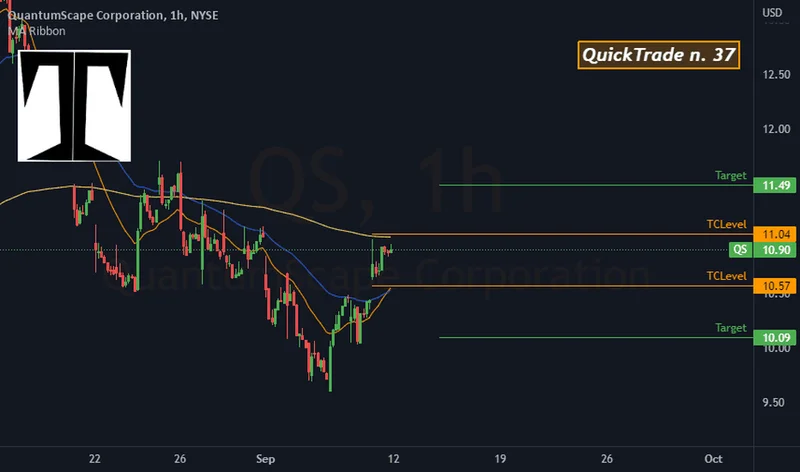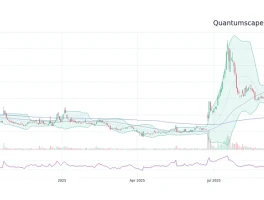It’s not often you get to watch the future click into place, but that’s what happened this week. You might have seen the headlines about the `qs stock price` surging, the frantic charts and the breathless financial news. But that’s just the signal, the aftershock of something far more profound. The real story isn't about a stock ticker; it's about a quiet announcement that just bridged the gap between a laboratory dream and the world we will all soon live in.
I’ve been following QuantumScape for years, watching them chase the holy grail of energy storage: a commercially viable solid-state battery. We’ve seen the promises, the prototypes, the slow, methodical march of science. We even saw a glimpse of its power just last month in Munich, where a fiery red Ducati race motorcycle, powered by their cells, sat silently on display at a Volkswagen press conference. A beautiful, potent symbol. But a symbol is not a revolution. A revolution needs an assembly line.
And now, it has one.
The news that QuantumScape is partnering with Corning is, to me, one of the most significant industrial announcements of the decade. To understand why, you have to understand the magic at the heart of QuantumScape’s technology. It all comes down to a component called the ceramic separator. This uses a solid, paper-thin slice of ceramic material to separate the anode and cathode—in simpler terms, it’s a stable, fireproof barrier that replaces the flammable liquid electrolyte found in virtually all of today’s lithium-ion batteries. This one change unlocks everything: dramatically faster charging, greater energy density (meaning more range), a longer lifespan, and a level of safety that current batteries simply cannot match.
It is, without exaggeration, the linchpin. The one piece that makes the entire paradigm shift possible. But making a few perfect ceramic films in a Silicon Valley lab is one thing. Making millions of them, flawlessly, every single week, is another. That’s not a science problem; it’s a manufacturing one.
This is where Corning comes in. Think about it. This is the company that has spent 170 years mastering the science of glass and ceramics on a global scale. They make the Gorilla Glass on your phone, the optical fiber that carries the internet, the advanced ceramics that enable catalytic converters. They don’t just innovate; they industrialize innovation. This partnership isn’t just a supplier agreement; it’s a passing of the torch from the scientists to the master builders. When I first saw the news, I honestly just sat back in my chair, speechless. This is the kind of breakthrough that reminds me why I got into this field in the first place.
This is the moment the abstract physics and the pristine lab results get their hands dirty and start becoming a real, tangible thing you can hold, a thing that can power your car, your home, our cities—the gap between the whiteboard and the world is closing at a dizzying speed.

Why Wall Street Is Weighing the Bolts on a Rocket Ship
From a Blueprint to the Global Freeway
What we’re witnessing feels like a historical echo. It’s not unlike the moment in the late 1950s when the first integrated circuits proved that you could etch an entire electronic system onto a tiny piece of silicon. The idea was brilliant, world-changing, but it was the subsequent development of mass-manufacturing techniques that truly ignited the digital revolution. QuantumScape’s ceramic separator is the silicon chip of the battery world. And Corning is building the foundry.
Of course, the market’s immediate reaction is financial. I’ve seen the skeptical takes. A headline might read, “it's a rich valuation to pay for a company that's yet to generate first sales.” And from a traditional, quarter-by-quarter perspective, they aren’t wrong. But they are missing the entire point. People who think that way are trying to value a rocket ship by weighing its bolts. You don’t value a company like this on its current sales. You value it on the scale of the problem it is about to solve.
Are investors betting on next quarter’s earnings? Of course not. They are making a bet, just as they did with `Nvidia stock` years ago, on the probability that our entire relationship with energy is about to be rewritten. A bet that the electric vehicle transition, currently paced by the limitations of `Tesla stock` and its competitors’ battery tech, is about to hit an accelerator pedal it didn’t even know it had.
Imagine an EV that charges in 15 minutes—the time it takes to grab a coffee. An EV with 500 miles of range, even in the cold. A battery that lasts for hundreds of thousands of miles, making the car’s power source a generational asset, not a depreciating component. This isn't just an incremental improvement. This is a fundamental re-architecting of personal mobility and energy storage itself.
And you can feel that shift in the collective consciousness. I was scrolling through the `qs stock Reddit` forums, and beneath the noise, you see the sparks of genuine understanding. One comment read, “People don’t get it. This isn’t about QS competing with other battery makers. This is about their tech making the entire EV pie 10x bigger.” Another user wrote, “The Corning deal is the final puzzle piece. The science was done. Now it’s an engineering and scaling problem, and they just hired the best in the world to solve it.” They see it. This isn't just about a stock; it's about being on the cusp of a tangible future.
With this power, of course, comes immense responsibility. As we stand at the threshold of this new energy paradigm, we have to ensure that the materials are sourced ethically, that the manufacturing processes are sustainable, and that the benefits of this leap forward are distributed equitably. Building a better battery is only half the mission; using it to build a better, cleaner, and fairer world is the true finish line. But for the first time in a long time, that finish line feels palpably within reach.
The Blueprint Becomes Reality
What we saw this week was the sound of a key turning in a lock we’ve been picking for decades. The academic papers have been published, the demos have been shown, and now the factory blueprints are being unrolled. The era of the liquid-filled lithium-ion battery, the technology that powered the first wave of our digital and electric lives, is now officially on the clock. The solid-state future is no longer a question of if, but of how soon. And the answer just got a whole lot sooner.
Reference article source:

